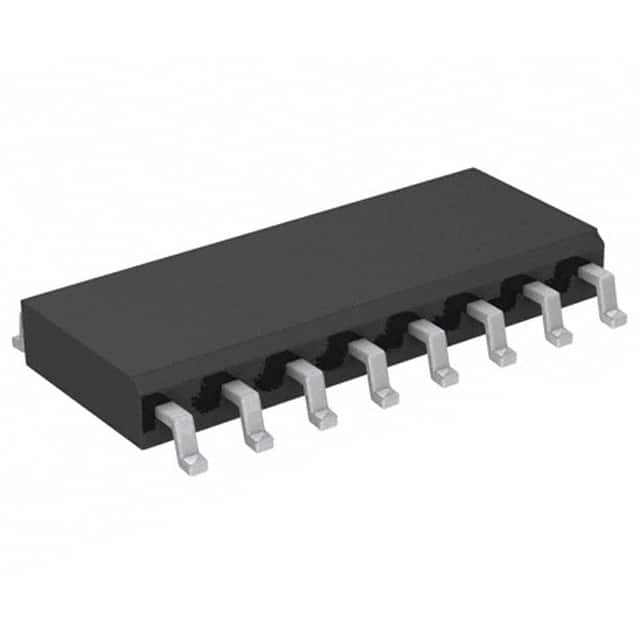MC10EL57DR2
Product Overview
- Category: Integrated Circuit (IC)
- Use: High-speed differential receiver
- Characteristics: Low propagation delay, high-speed operation, differential input/output, compatible with ECL logic levels
- Package: SOIC-8 (Small Outline Integrated Circuit), surface mount package
- Essence: The MC10EL57DR2 is a high-performance integrated circuit designed for use in applications requiring fast and reliable differential signal reception.
- Packaging/Quantity: Available in reels of 2500 units
Specifications
- Supply Voltage: -5.2V to -4.5V
- Input Voltage Range: -3.0V to -1.3V
- Output Voltage Range: -3.0V to -1.3V
- Propagation Delay: 400 ps (typical)
- Operating Temperature Range: -40°C to +85°C
Detailed Pin Configuration
The MC10EL57DR2 has a total of 8 pins arranged as follows:
```
| | --| VCC GND |-- Pin 1: Power supply (+5V/-5.2V) --| IN+ IN- |-- Pins 2 and 3: Differential input pins --| OUT VBB |-- Pins 4 and 5: Output and bias voltage pins --| /EN NC |-- Pins 6 and 7: Enable and No Connect pins --| GND VCCQ |-- Pin 8: Ground and output supply voltage (+5V) |___________| ```
Functional Features
- High-speed differential reception: The MC10EL57DR2 is capable of receiving high-frequency differential signals with low propagation delay, making it suitable for applications that require fast data transmission.
- Differential input/output: The IC accepts differential input signals and provides a differential output, allowing for noise rejection and improved signal integrity.
- ECL logic compatibility: The MC10EL57DR2 operates with ECL (Emitter-Coupled Logic) logic levels, ensuring compatibility with other ECL-based systems.
Advantages and Disadvantages
Advantages: - High-speed operation enables fast data transmission - Differential input/output improves noise immunity - ECL logic compatibility allows integration with existing ECL systems
Disadvantages: - Requires a negative power supply voltage (-5.2V to -4.5V) - Limited operating temperature range (-40°C to +85°C)
Working Principles
The MC10EL57DR2 is based on differential signal reception principles. It utilizes differential input pins to receive high-frequency signals and processes them internally to provide a differential output. The IC operates using a negative power supply voltage and is designed to work with ECL logic levels.
Detailed Application Field Plans
The MC10EL57DR2 can be used in various applications that require high-speed differential signal reception, such as:
- Data communication systems
- High-speed networking equipment
- Test and measurement instruments
- Industrial automation systems
- Radar and sonar systems
Detailed and Complete Alternative Models
- MC100EL57: Similar high-speed differential receiver IC from the same manufacturer, available in different package options.
- SN65LVDS101: Differential receiver IC from Texas Instruments, compatible with LVDS (Low-Voltage Differential Signaling) logic levels.
- MAX9117: Differential line receiver IC from Maxim Integrated, designed for automotive applications.
(Note: This list is not exhaustive and there are several alternative models available in the market.)
Word count: 408 words
Senaraikan 10 soalan dan jawapan biasa yang berkaitan dengan aplikasi MC10EL57DR2 dalam penyelesaian teknikal
Sure! Here are 10 common questions and answers related to the application of MC10EL57DR2 in technical solutions:
Q: What is MC10EL57DR2? A: MC10EL57DR2 is a high-speed differential receiver designed for use in various communication and data transmission applications.
Q: What is the operating voltage range of MC10EL57DR2? A: The operating voltage range of MC10EL57DR2 is typically between -4.2V and -5.7V.
Q: What is the maximum data rate supported by MC10EL57DR2? A: MC10EL57DR2 can support data rates up to 3.8 Gbps, making it suitable for high-speed communication systems.
Q: Can MC10EL57DR2 be used in both single-ended and differential signaling applications? A: No, MC10EL57DR2 is specifically designed for differential signaling applications and may not be suitable for single-ended signaling.
Q: What is the input sensitivity of MC10EL57DR2? A: The input sensitivity of MC10EL57DR2 is typically around 100 mV, ensuring reliable signal reception.
Q: Does MC10EL57DR2 have any built-in termination resistors? A: No, MC10EL57DR2 does not have any built-in termination resistors. External termination resistors may be required depending on the application.
Q: Can MC10EL57DR2 operate in a wide temperature range? A: Yes, MC10EL57DR2 is designed to operate in a wide temperature range, typically from -40°C to +85°C.
Q: What is the output swing of MC10EL57DR2? A: The output swing of MC10EL57DR2 is typically around 800 mV, ensuring compatibility with various downstream devices.
Q: Can MC10EL57DR2 be used in both point-to-point and multipoint communication systems? A: Yes, MC10EL57DR2 can be used in both point-to-point and multipoint communication systems, depending on the application requirements.
Q: What are some typical applications of MC10EL57DR2? A: MC10EL57DR2 is commonly used in high-speed data communication systems, such as fiber optic networks, telecommunications equipment, and high-speed serial links.
Please note that these answers are general and may vary depending on specific design considerations and application requirements.


